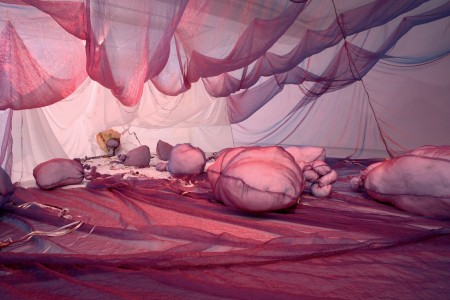Nicholas Hlobo
Phalluses, saddles and South Africa; handmade costumes and the Xhosa language
Phalluses, saddles and South Africa; handmade costumes and the Xhosa language

Innuendo is key to the burgeoning practice of Johannesburg-based artist Nicholas Hlobo, although there is also something markedly clear, even forceful, about an encounter with any one of his many phallic sculptures. Take, for example, the deliriously out-of-kilter penis he exhibited on his début solo outing, ‘Izele’ (2006), at Cape Town’s Michael Stevenson gallery in 2006. Attached to a spring weighing scale, a life-size rubber phallus (Isisindo samadlozi, 2006) hovered above two grossly oversized testicles made from pieces of inner tyre tubing stitched together with bits of pink and white ribbon. Recently reprising the idea in another exhibition at the same venue, Hlobo (who is having a solo show at the ICA Boston in June) presented a leather riding saddle fitted with an erect rubber shaft, the construction weighted down on each side with oversized, stitched sacks (Izinganda mathe, 2008). ‘I come from a culture where the penis is very important,’ Hlobo once stated with pointed clarity.
Still, despite the symbolic heft of his numerous phallic creations in a country where circumcision rituals are still central to many indigenous cultures, including the Xhosa to which Hlobo belongs, and where AIDS is rampant and the rape of children commonplace, it is remarkable how often the artist is seemingly caught on the back foot, made to peel away the layers defining his remarkably physical, audaciously cryptic constructions. ‘Through my works I attempt to create conversations that explore certain issues within my culture as a South African,’ a local reporter quoted him as saying on the occasion of his first US solo exhibition, held at the Savannah College of Art and Design in Georgia last year. ‘The conversations become a way of questioning people’s perceptions around issues of masculinity, gender, race and ethnicity.’
When Hlobo presented his début solo exhibition, his resolutely queer, process-bound collection of sculptural objects included a devastatingly camp refashioning of a circular Zulu kraal. Made from wood harvested from a rocky ridge near his home in central Johannesburg, the artist’s rural icon of wealth was further adorned with a weave of pink ribbons (evoking a trampoline) that tailed off to a testicle-like object made from stitched rubber. Titled Umthubi (2006), after the milky porridge that herders feed to newborn calves, his architectural construction showcased a material irreverence not really seen in South Africa since Moshekwa Langa’s stellar début in the mid-1990s. It also announced an artist thoughtfully obsessed with sex. Male sex. Gay sex. Sex as obscured metaphor.
As it turns out, the triumphant phalluses, ovarian spaces and growing number of handmade costumes (which he uses in performances) are constantly modulated by Hlobo’s use of linguistic innuendo. Xhosa through birth, the artist, who worked as a cement factory labourer for two and a half years before entering art school, often titles works in his native language. ‘I am trying to learn the language and really understand it, and at the same time teach others,’ he says. The outcome is a marked tension between the apparent, visible forms and surfaces of his constructions and their latent, linguistically charged connotations. Rather than allow these tensions to determine their own passage through the world, Hlobo is prone to overcompensate, his generous explanations tending to clarify the manifold layers, visible and invisible, cloaking his work. Crucial here is the fact that the artist’s address is often pitched at a white art world – in South Africa and beyond – most, if not all, of whom are unable to comprehend his native tongue.
‘The choice of language and the use to which language is put is central to a people’s definition of themselves in relation to their natural and social environment, indeed in relation to the entire universe,’ wrote the Kenyan writer Ngugi wa Thiong’o in 1981. Given apartheid’s attempts to create a hollow pantomime of cultural memory and continuity, to lightly paraphrase Benjamin Buchloh, the reclamation implicit in Hlobo’s methods, in particular his use of his native language to title his work, cannot be ignored – even if it sometimes misses those best equipped to understand his point, without being lectured to.
‘Most people I know say my work is so not black,’ quips Hlobo, who, like Langa, has forged his own unique aesthetic. On not being representative, Hlobo simply states: ‘I quite enjoy that, because I am somehow celebrating all my heritages: my African heritage, my colonial heritage, all those things personal to me – the language I speak, my Xhosa.’ Not surprisingly, the seam, whether bright pink or blue, becomes the defining metaphor of his work, grafting histories and reconciling opposites.
But what is one to make of his use of a globalised marketing vernacular, ‘my’ this, ‘my’ that? ‘I think there is a lot of my, my, my in all the assertions I make – my culture, my inherited colonial heritage. I think there is a lot of being possessive about certain things,’ he concedes. Which is just how he likes it. ‘Removing myself is something I find very difficult and a little boring.’















